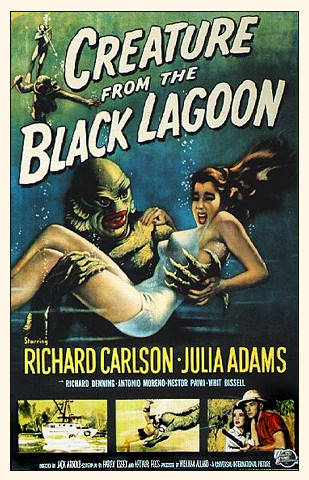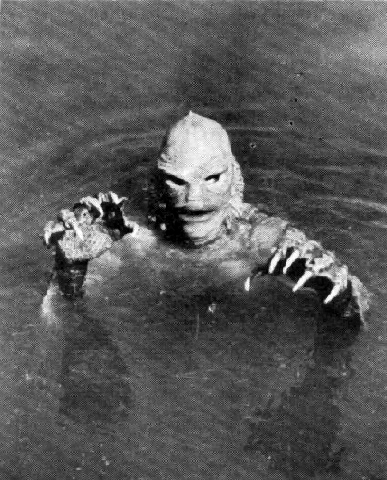 |
The movie posters (move the mouse
over the image to reveal the poster for the sequel) tell us something about
how the film was marketed to attract audiences. Notice the gill-man's bared
teeth. He appears threatening in the picture, yet in the film, he does not
act violently towards Kay. In the second poster, the Creature appears stronger.
He is holding the woman with one arm while the useless chain swings beneath
her, creating the illusion that she is bound to him.
Universal seems to play up the sexual angle
of the story by displaying women prominantely in both posters. However,
notice the contrast between Kay's pure white swimsuit and Helen's flaming
red gown. Furthermore, Kay is screaming and actively resisting the monster,
while Helen has either been overcome or has surrendered willingly to the
gill-man. Perhaps this reflects the Creature's lost innocence from one film
to the next. Or perhaps it is simply an attempt to lure more men into the
theaters... |
|
"You know the feeling
when you are swimming and something brushes your legs down below--it scares
the hell out of you if you don't know what it is. It's the fear of the
unknown. So I decided to exploit this fear as much as possible in filming
Creature from the Black Lagoon."
--Jack
Arnold, director and co-writer (Brosnan, 92)
The gill-man, like King Kong, threatens
society's relationship boundaries. The Creature shows distinct interest
in the female member of the expedition, Kay. At first, he is a bashful
observer of the woman's playful swimming and he demonstrates empathy through
mimicry (Jancovich, 179). As long as distance is maintained, there is
harmony among the characters. However, when the gill-man ventures into
Kay's air-filled world, her reaction to his appearance is surprise (vocalized
as a scream). The peace is shattered and the men are spurred into violent
action. Society, represented by the men of the expedition, cannot abide
by the Creature's attention to Kay. When he finally closes the gap between
Kay and himself, taking her away from the men who dismantle the earth's
crust and threaten his independence, a showdown occurs between the gill-man
and David, her other suitor. With help from rifle-toting comrades, David
claims Kay for himself. He then asserts his dominance by permitting the
gill-man to return, broken, to the water. The pairing of unlike characters
is not tolerated, and the taboo against intimacy between individuals of
different race, class, or-as in this case-species is reinforced.
 The
gill-man is an evolutionary adolescent, caught between the aquatic childhood
of primordial life and the terrestrial adulthood of modern humanity (181).
He is shown at the left emerging from the water, like a pioneering species
millions of years ago. For eons he has lived undisturbed but by a few
errant natives who created legends to preserve their existence and insulate
his world. As modern scientists encroach upon his Lagoon, the Creature
fights to defend his home (178). The more he struggles to maintain the
sanctity of his Lagoon; the more fear is conjured up in the scientists.
The expeditionists confront their fear with the tools of evolved man.
The mature male figures in the film are rational scientists, dependent
on reason and intent on fulfilling goals. They analyze, plan, and prepare
their tools while the Creature watches and reacts. When the Creature does
enact a plan (using Kay as bait to draw rival David into the open), he
is rendered powerless in a world he in which he does not belong. The gill-man
finds himself in a rivalry for a woman as a mate, requiring strategies
to achieve his goals. These qualities are associated with the humans that
have evolved and do not fit the gill-man's natural profile. By playing
by modern rules, the ancient Creature forfeits his innocence and his existence.
Therefore, the Creature's resistance to evolution was tragically futile. The
gill-man is an evolutionary adolescent, caught between the aquatic childhood
of primordial life and the terrestrial adulthood of modern humanity (181).
He is shown at the left emerging from the water, like a pioneering species
millions of years ago. For eons he has lived undisturbed but by a few
errant natives who created legends to preserve their existence and insulate
his world. As modern scientists encroach upon his Lagoon, the Creature
fights to defend his home (178). The more he struggles to maintain the
sanctity of his Lagoon; the more fear is conjured up in the scientists.
The expeditionists confront their fear with the tools of evolved man.
The mature male figures in the film are rational scientists, dependent
on reason and intent on fulfilling goals. They analyze, plan, and prepare
their tools while the Creature watches and reacts. When the Creature does
enact a plan (using Kay as bait to draw rival David into the open), he
is rendered powerless in a world he in which he does not belong. The gill-man
finds himself in a rivalry for a woman as a mate, requiring strategies
to achieve his goals. These qualities are associated with the humans that
have evolved and do not fit the gill-man's natural profile. By playing
by modern rules, the ancient Creature forfeits his innocence and his existence.
Therefore, the Creature's resistance to evolution was tragically futile.
|